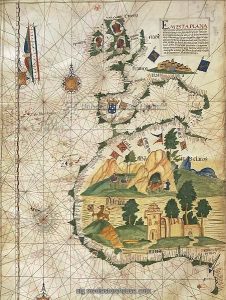Logistical information
TA’s office hours are on Wednesdays 7-8. If this does not work for you, you can email Marina and work other times out with her.
Professor Holt started off class by saying that if you have NOT picked up a book pecha kucha date, you need to do that immediately. She showed two examples in class today from previous classes. If you did not sign up for Class Notes or the News Blog Post, you have been assigned a date already. So, go ahead and sign yourself up for a date/book to present! All these sign up links can be found on the course website.
There is a Great Decisions Series event this year with several speakers. It is called Resurgent Nationalism & and Borderless Problems. Professor Holt has posted the details with regards to this event on our dashboard.
Class Material
Key Terms:
Treaty of Tordesillas – Signed June 7, 1494, its an agreement between Spain and Portugal aimed at settling conflicts over lands newly discovered or explored by Christopher Columbus and other late 15th-century voyagers.(Brittanica)
Pentimento – A visible trace of earlier painting beneath a layer or layers of paint on a canvas. (Wikipedia)
Primary Sources – In the study of history as an academic discipline, a primary source is an artifact, a document, diary, manuscript, autobiography, a recording, or any other source of information that was created at the time under study. (Wikipedia)
Secondary Sources – A document or recording that relates or discusses information originally presented elsewhere. (Wikipedia)
Historiography – Entering into the wider scholarly conversation about a research question by analyzing the relevant secondary sources. (Professor Holt)
Iberian Peninsula – The Iberian Peninsula is a mountainous region that’s most associated with the countries of Spain and Portugal. (Wikipedia)
Class Discussion:
Todays discussion focuses on Brazilian Civilizations Pre-1500 and the Portuguese Empire in 1500. Today’s discussion question is: How and why does the cannibalism come so central to the 16th century European depictions of Brazil?
Background history:
Geography is important in this story. Portugal is a maritime empire on the fringes of Europe. Part of old an mediterranean world. Iberians have a tradition of trying to control muslims and jews even with a long history of coexistence. There are African muslims in Portugal and Spain. The Iberian Peninsula is very special due to its geographical barriers to the rest of Europe. Pyrenees Mountains cut Iberia from europe.
Portugal in the 1400-1500 is putting a lot of effort to develop technology navigation. Developments include: ship building, navigation, cartography, calculating longitude and latitude, etc. They are thinking of how to get to the Middle East, Africa, and India in shortest time Possible. Portugal and Spain set up trading ports in Africa but did not stay and or conquer. Portuguese are not trying to send farmers to take coastlines, they are trying to establish mercantilism and make money. Enrich people back in Portugal.

Cartography, 16th century. Map of Western Africa. From the Atlas by Lazaro Luis, 1563.
Portugal are controlling global traffic with outside world due to their sophisticated navigation. Portugal did a good job describing a coastal knowledge. Just how they map the coast well in the Lazaro Luis map, they do the same thing with coastal Brazil. They are focusing on colonialism to enrich Portugal rather than settling. Their colonization and exploitation of land is very profitable to the Portuguese. Later, they use their contacts and controls to be the biggest single largest importer of African slaves to produce sugar. Sugar mills were built in Bahia, 1549. They turn to African slavery because of the people they find in Brazil. Native Brazilians would either flee back into the heart of the Amazon or die off from European diseases.
Someone mentions that this statement contradicts the readings because the readings say indigenous people were also enslave, easier to keep, and cheaper to own. Although that is true, Marina said the Portuguese spared the indigenous people because the Pope believed they could be Christianized. The Pope said that Africans have no souls and that indigenous people have not been exposed to Christianity yet, so they must be converted to be saved.
We then broke into Early Brazilian Books Project Groups
We were to discuss our interpretation of the Patricia Seed article:
We agreed that we need to think critically of the primary sources used because they were written by white European men who were very wealthy at the time. There is only one perspective taken into account.
We agreed Europeans justify their colonization when they see cannibalism as an unorthodox tradition. This fact was used against the native Brazilian people to deem them as wild and godless. In fact, there are only some isolated tribes that practice cannibalism for warfare, ceremonies, revenge, yet there was a series of over-exaggeration. Most of the people of Brazil actually did not engage in Cannibalism.
We questioned people why people were so obsessed with cannibalism issue if it happened in Europe as well. Catholics also do it. Nudity is also over-expressed as primitive and wild.
Woo mentioned that Indigenous culture was portrayed as nomadic and primitive. Although they acknowledge some skill and sophistication, Europeans choose to generalize and deem these civilizations as primitive.
We came back together as a group and agreed we need to look at secondary sources such as Seed’s work to fully understand the interactions with Brazilians and Europeans. It is important to look at what is given in primary sources and critically analyze their validity, bias, and accuracy.
Further Discussion Questions (Optional):
Why do Europeans completely negate the sophistication of Native-American societies?
Do you believe any Europeans that landed on Brazil truly believed that converting the people would help everyone, or was it just an excuse to take over?
